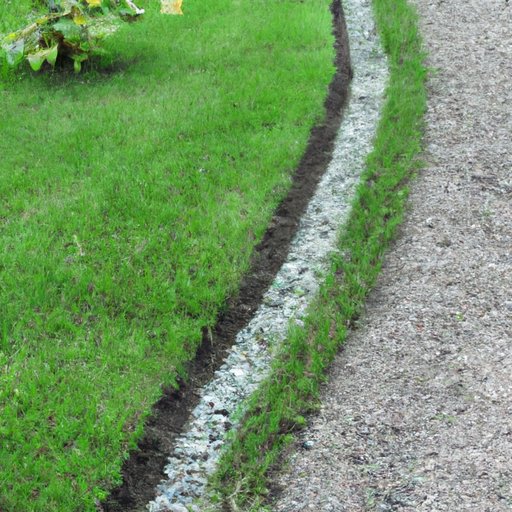
Introduction
Do you want to take your lawn to the next level? Look no further than edging! Edging is the process of creating a clean and distinct separation between your lawn, garden beds, and other landscaping features. Not only does it make your yard look more manicured and polished, but it also serves practical purposes, such as preventing grass and weeds from encroaching on your garden beds. In this ultimate guide to edging, we’ll cover everything you need to know to get started, from the basics to creative ideas, maintenance strategies, and more.
The Beginner’s Guide to Edging: Improve Your Landscaping Skills
Before getting into the creative side of edging, let’s start with the basics. First, it’s important to understand why edging is important. Edging creates a clear separation between different areas of your yard and prevents grass and weeds from spreading into unwanted areas. To achieve a clean, straight line, you will need to use the right tools for the job. Lawn edgers, spades, and string trimmers are all excellent options to consider.
When it comes to achieving sharp lines, using stakes and string as a guide can be incredibly helpful. Simply set up stakes at the beginning and end of the area you want to edge and run a string between them. This will help ensure a straight and even edge. It’s also important to keep your tools sharp and in good condition for the best results.
5 Creative Edging Ideas to Make Your Yard Stand Out
If you want to take edging to the next level, consider using unique materials like rocks, bricks, and plants to create a distinctive border. Here are five creative ideas to get you started:
1. Using plants as edging
Many plants, such as boxwood or lavender, can be used to create an attractive and functional border around your garden beds. This type of edging looks especially beautiful when paired with flowers or other plants that complement the color and texture of the border plants.
2. Creating a border with rocks or boulders
Large rocks or boulders can be used to create a strong and durable border around your yard. This type of edging works especially well in naturalistic or rustic landscapes.
3. Using bricks or pavers as edging
Bricks or pavers can be used to create a classic, formal look in your yard. Consider using bricks or pavers in different colors or patterns to add additional visual interest.
4. Incorporating a water feature as part of the edging
If you have a pond or other water feature in your yard, you can use edging materials that match the style of your feature to create a unified look. This works especially well when using rocks or boulders.
5. Creating a curving edge using a garden hose as a guide
If you want a more fluid, organic look to your edging, try using a garden hose as a guide. Simply lay the hose down in the shape you want and use a spade or lawn edger to cut along the edge of the hose. This method works particularly well for creating curved or irregular shapes.
Edging as a Maintenance Strategy: Keeping Your Lawn in Shape Year-Round
Edging isn’t just about creating a beautiful yard. It’s also an important part of overall lawn maintenance. Keeping the borders of your lawn and garden beds clean and distinct helps prevent grass and weeds from spreading, which can save you time and effort in the long run. However, the frequency with which you will need to edge your yard will depend on factors such as the season, weather conditions, and the overall health of your lawn.
In general, it’s a good idea to edge your lawn and garden beds at least once a month during the growing season to keep everything looking neat and tidy. In the winter months, you can typically get away with edging less frequently. However, if you notice that grass and weeds are encroaching on your beds or paths, it’s time to break out the edging tools again.
The Pros and Cons of DIY Edging vs. Hiring a Professional
When it comes to edging your yard, you have the option of doing it yourself or hiring a professional landscaper. Both options have their benefits and drawbacks.
Benefits of DIY edging
- Cost-effective
- Greater control over the outcome
- Ability to complete the project at your own pace
Potential drawbacks of DIY edging
- Lack of expertise or experience can lead to subpar results
- May require upfront investment in tools or equipment
- Can be time-consuming and physically demanding
Benefits of hiring a professional
- Expertise and experience in achieving a high-quality look
- Potentially saves time and effort on your part
- Can provide a professional-grade finish that may be difficult for a novice to achieve
Potential drawbacks of hiring a professional
- Cost can be higher than doing it yourself
- Less control over the outcome
- May require scheduling around the availability of the landscaper
Edging for Curb Appeal: Making Your Home Look its Best
Finally, it’s worth noting that edging can contribute significantly to a home’s overall curb appeal. By choosing edging materials that complement your home’s color and style, you can create a cohesive and welcoming look. Consider using edging materials that match the color of your home’s siding or trim for a unified look. Alternatively, if you want to create a contrast, opt for materials with a color or texture that complements but doesn’t match your home’s exterior.
Conclusion
Whether you’re a seasoned landscaper or a new homeowner, edging is an important part of maintaining a beautifully manicured yard. By following these tips and tricks, exploring creative ideas, and understanding the importance of regular maintenance, you can create a yard that’s a source of pride and enjoyment.





